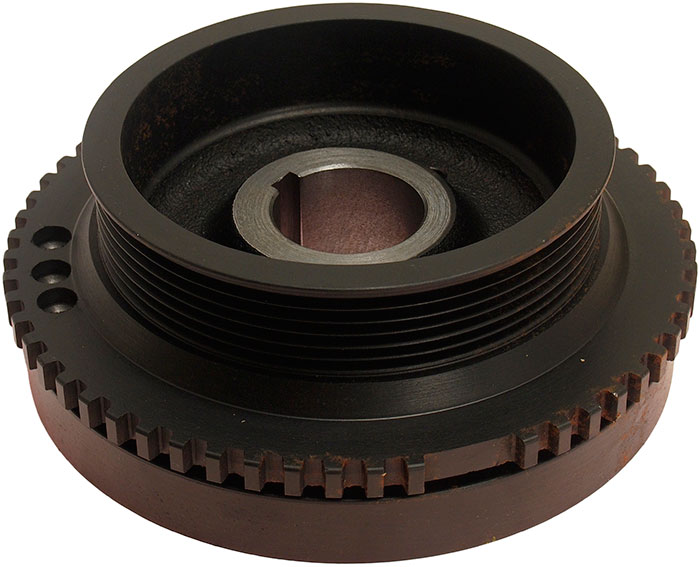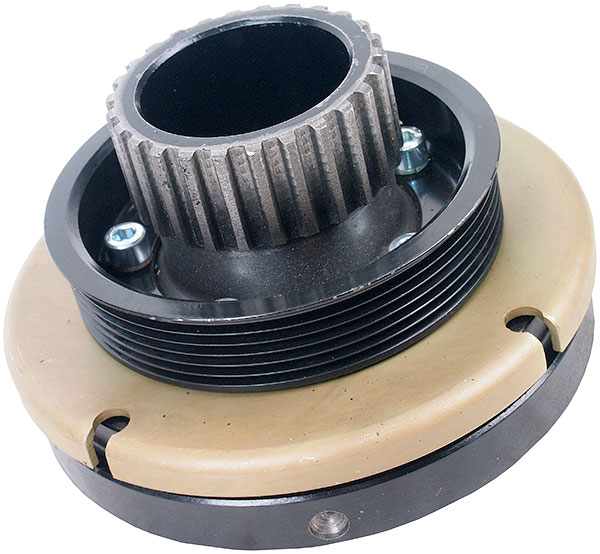
n any internal combustion engine, the main and auxiliary mechanisms are driven from the crankshaft using a pulley and a belt. Read about what a crankshaft pulley is, what types of it exist, how it works and functions, as well as replacing and repairing a pulley in the proposed article.
Purpose and role of the crankshaft pulley
Any internal combustion engine contains several systems that require a source of mechanical energy to operate. Such systems include a gas distribution mechanism, lubrication and cooling systems, contact ignition systems with a breaker-distributor, fuel supply systems and others. The source of energy for all these systems is the crankshaft - it is from it that part of the torque is taken, which is used to drive the shafts, pumps, generator and other units. At the same time, several separate drives are used in the engine: a timing belt or chain drive and gear drives of the units. Here we will consider only belt drives, which include a crankshaft pulley.
The crankshaft pulley is a part of the timing belt drive and other auxiliary mechanisms of internal combustion engines (both gasoline and diesel). The pulley is located on the toe (that is, in the front) of the crankshaft, it is used to drive the camshaft (or shafts), as well as a number of units - a liquid pump (pump), a generator, a power steering pump, a cooling fan, an air conditioning compressor, a pneumatic compressor and others.
Also, the crankshaft pulley can perform two auxiliary functions:
- Tracking the angular velocity and position of the crankshaft using the appropriate sensor;
- Damping of vibrations that occur during engine start/stop and transient conditions.
In general, the crankshaft pulley, despite its simplicity and invisibility, is an important part of any modern engine. Today, there is a wide variety of these components, and they all solve different problems.
Types and design features of crankshaft pulleys
Engines use two main types of crankshaft pulleys, which differ in design and purpose:
- Brook pulleys for V-belt transmission;
- Toothed pulleys for the toothed belt.
Brook pulleys are a classic solution that has been used on internal combustion engines since their inception. The outer surface of such a pulley has one or more V-shaped streams, which include a belt of the appropriate shape (V-shaped or V-rib). Such pulleys are used only in V-belt transmissions, in which there is no need for precise installation of the crankshaft and units relative to each other. Such gears include the drive of the water pump, generator, air conditioning compressor, air compressor, fan and timing pump.
Toothed pulleys are a modern solution that has been used on engines for the last two to three decades. Such pulleys are used in gears with timing belts, which replace the timing chain drive. The toothed pulleys of the crankshaft and units and the timing belt connecting them ensure a certain position of the units relative to each other. In most cases, the toothed pulley is used to drive the timing and water pump, and the drive of the remaining units is carried out by a separate V-belt transmission.
There are also combined pulleys, which are a structure of toothed and wedge (or V-ribbed) pulleys. Such pulleys are used to drive the timing and a number of auxiliary units of the engine. There can be several (up to four) wedge/V-ribbed pulleys in this design.
All these pulleys are divided into two types by design:
- One-piece/milled;
- Composite damped.
Pulleys of the first type are solid parts cast or carved from a single piece of metal (cast iron or steel). Such pulleys are the simplest and cheapest, but they transmit to the units all the vibrations that occur when the crankshaft rotates.
Pulleys of the second type are composite, they consist of a hub and a ring connected through a rubber ring. Due to the presence of a rubber ring, the hub and crown are decoupled, so the vibrations and vibrations that occur during the rotation of the crankshaft are attenuated. Such pulleys are heavier, more complex and more expensive, but this pays off with better reliability and durability of the entire belt drive.
Also, pulleys are divided into two groups according to the type of fastening:
- Fastening with a central bolt and key;
- Fastening with several (2-6) bolts.
In modern engines, the crankshaft pulley, especially in the case of a timing belt drive, is most often mounted on a single bolt, and is kept from turning with a key. Auxiliary pulleys can be fastened with several bolts, and the installation is carried out on the hub, which is either a continuation of the timing chain drive sprocket, or cast on the toe of the crankshaft, or is an independent part with keyway fastening on the toe of the shaft.
On the pulleys of modern engines, in addition to streams or teeth under the belt, a ring gear can be made for the operation of the crankshaft position sensor (DPKV). The crown is the so-called master disc of the crankshaft sensor, it can be molded together with the pulley, or it can be made as a separate part with bolting.
Any crankshaft pulley is balancing during manufacture to eliminate vibrations and beats. To remove excess metal, small depressions are drilled in the pulley.

Issues of replacement and repair of the crankshaft pulley
The crankshaft pulley is a reliable and durable part, but over time, it may be damaged and failed. If wear of the toothed pulley is detected, as well as in the event of cracks, breaks, deformations and other damage, the pulley should be dismantled and replaced with a new one. Dismantling the pulley may also be required when performing repair work on the engine.
The process of replacing the crankshaft pulley depends on the type of its attachment. The easiest way is to remove the pulley on the bolts - just unscrew the bolts, while fixing the crankshaft, preventing it from turning. Dismantling a toothed pulley on a single bolt is somewhat more complicated and generally looks like this:
1.Fix the car by placing stops under the wheels, in the case of a gasoline engine, remove the connector from the ignition coil (so that the starter turns, but the engine does not start), in the case of a diesel engine, remove the connector from the fuel supply valve of the injection pump;
2.Treat the bolt with any means that will help tear the fasteners out of place without breaking it;
3.Put a key with a long handle on the bolt, it should reach the floor, or additionally use a pipe;
4.Turn the engine with the starter - in this case, the bolt should turn. If it doesn't work the first time, then you can repeat;
5.Unscrew the bolt;
6.Using a special puller, dismantle the pulley from the toe of the crankshaft.
It should be noted that to access the pulley in cars with a longitudinal engine, it is better to use the inspection pit, and in cars with a transverse engine, the right wheel will have to be dismantled.
When breaking the bolt, care should be taken - it is screwed in with great effort, so the risk of its breakage is quite high. It is recommended to remove the pulley from the crankshaft using a special puller, although you can use a simple mounting blade, but in this case you should also be careful. Some pulleys have special threaded holes into which you can screw the bolts and remove the pulley. However, in this case, a steel sheet should be placed under the screwed bolts, since the bolt can push through the front wall of the engine block or other parts located under it.
Installation of the crankshaft pulley is carried out in reverse order. However, there may be a difficulty, since the pulley is tightly installed on the toe of the crankshaft, which requires a lot of physical effort. The landing site of the pulley can be treated with grease to facilitate its installation.
With proper replacement of the crankshaft pulley, all engine units will operate normally, ensuring reliable operation of the entire power unit.
Post time: Aug-27-2023
